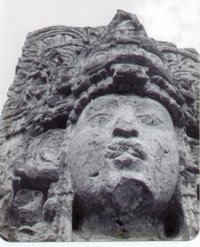|
|
CopánMap.jpg
The Pre-Columbian city of Copán is a locale in extreme western Honduras, in the Copán Department, near to the Guatemalan border. It is the site of a major Maya kingdom of the Classic era.
The kingdom, anciently named Xukpi (Corner-Bundle), flourished from the 5th century AD to the early 9th century, with antecedents going back to at least the 2nd century AD. Its name is an apparent reference to the fact that it was situated at the far southern and eastern end of Maya territory. The city of Copán itself may have anciently been known as Oxwitik.
| Contents |
Description of the ruins
CopanHieroglyphStairs.jpg
The city of Copán is perhaps best known for producing a remarkable series of portrait stelae, most of which were placed along processional ways in the central plaza of the city and the adjoining "acropolis" (a large complex of overlapping step-pyramids, plazas, and palaces). The stelae and sculptured decorations of the buildings of Copán are some of the very finest surviving art of ancient Mesoamerica.
Many structures are elaborately decorated with stone sculptures, usually constructed from a mosaic of carved stones of a size that one person could carry.
CopanBallgame.jpg
The site also has a large court for playing the Mesoamerican ballgame.
At its height in the late classic period Copán seems to have had an unusually prosperous class of minor nobility, scribes, and artisans, some of whom had homes of cut stone built for themselves (in most sites a privilege reserved for the rulers and high priests), some of which have carved hieroglyphic texts.
CopanTempleOfInscriptions.jpg
The buildings suffered significantly from forces of nature in the centuries between the site's abandonment and the rediscovery of the ruins. There have been numerous earthquakes -- no roofs of the stone buildings intact when the site was rediscovered, and the hieroglyphic stairway was collapsed. The Copán river changed course and meandered, destroying part of the acropolis and apparently wiping out various subsidiary architectural groups in the region. In the long period when the site was overgrown the buildings and scuptures suffered from the invasive thick jungle vegetation and periodic forest fires.
Archeologists have consolidated and restored many structures at the site.
Pre-Columbian history
The fertile Copán River valley was long a site of agriculture before the first known stone architecture was built in the region about the 9th century BC.
A kingdom seems to have been established in Copán in 159. It grew into one of the most important Maya sites by the 5th century. Large monuments dated with hieroglyhic texts were erected in the city from 435 through 822.
Xukpi was one of the more powerful Maya city states, a regional power, although it suffered a catastrophic defeat at the hands of the kingdom located at Quirigua in 738. It eventually withered in the face of the depletion of natural resources which was a factor in bringing most of the Classic-Age Maya city-states to their end.
The area continued to be occupied after the last major ceremonial structures and royal monuments were erected, but the population declined in the 8th century - 9th century from perhaps over 20,000 in the city to less than 5,000.
The ceremonial center was long abandoned and the surrounding valley home to only a few farming hamlets at the time of the arrival of the Spanish in the 16th century.
List of known Xukpi rulers
Stela_A.jpg
- K' inich Yax K'uk' Mo' before 426-437
- K'inich Popol Hol c. 437
- 1 King, name unknown c. 455
- Cu Ix c. 465
- 2 Kings, names unknown, 476, 485
- Waterlily-Jaguar after 504-544
- 2 Kings, names unknown; last one died 553
- "Moon Jaguar" 553-578
- Butz' Chan 578-628
- Smoke Imix K'awiil 628-695
- Uaxaclajuun Ub'aah K'awiil ("18 Rabbit") 695-738
- K'ac Joplaj Chan K'awiil ("Smoke Monkey") 738-749
- K'ac Yipyaj Chan K'awiil ("Smoke Shell"; "Smoke Squirrel") 749-763
- Yax-Pasaj Chan Yoaat ("Yax Pac") 763-after 810
- (probably period where throne was vacant)
- U-Cit-Tok 822
- Royal ceremonial center of city abandoned by 827
The first sixteen names, from Yax K'uk' Mo' to Yax Pac, are depicted on Altar Q, an artifact that has provided researchers clues to the history and origins of Copán.
Copán in modern times
CopanNSouthCatherwood.jpg
By the time of the Spanish conquest of Honduras, the site had long been overgrown by rainforest. Although this large ruined city was known locally since early colonial times, it remained largely unknown by the outside world until a series of explorers visited it in the early 19th century. Juan Galindo wrote a description of the ruins in 1834, which was published the following year. This sparked the interest of North American explorer and travel writer John Lloyd Stephens and English architect and draftsman Frederick Catherwood whose illustrated books describing Copán and other sites excited a great deal of interest in Mesoamerican antiquities among American and European scholars, and its publication is regarded as the commencement of modern Mayan studies which continue to this day.
The site was the subject of one of the first modern archeological surveys and excavations in the Maya area, conducted by the Peabody Museum and Harvard University from 1891 to 1894. Further excavations and restorations were begun by the Carnegie Institution in the 1930s, the Peabody Museum again in the 1970s, followed by the Government of Honduras's Proyecto Copán beginning in the late 1970s and continuing to this day.
See also:
Books for further reading
- Copán by Francis Robicsek, Museum of the American Indian, 1972
- Scribes, Warriors and Kings: The City of Copán and the Ancient Maya by William L. Fash, Thames and Hudson, 1991
External links
- "Lost King of the Maya" site on pbs.org (http://www.pbs.org/wgbh/nova/maya/) companion site to "Nova" television documentary on Copán
- Hieroglyphs and History at Copán (http://www.peabody.harvard.edu/Copan/text.html) by David Stuart on peabody.harvard.edu
fr:Copán de:Copán es:Copán nl:Copán pl:Copán pt:Copán sk:Copán sv:Copán

